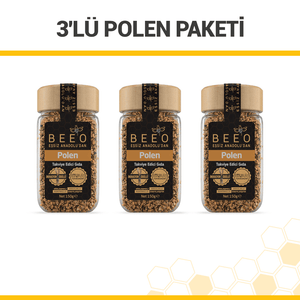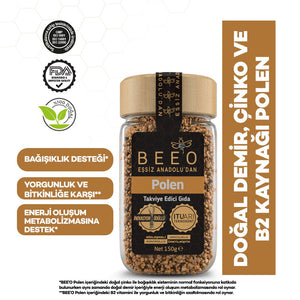p{
font-size: 16px;
margin-bottom: 0px;
padding: 10px 0px;
border: 0px;
outline: 0px;
vertical-align: baseline;
text-indent: 0px;
font-family: Verdana;
}
h2{
margin-bottom: 0px;
padding: 10px 0px;
border: 0px;
outline: 0px;
vertical-align: baseline;
font-family: Verdana;
font-size:20px;
font-style:bold;
}
.liste-1{
list-style-position: inside;
text-indent: 60px;
}
Vitamin and mineral rich BEE'O Pollen is available at a discounted price of 3!
Pollen contributes to the normal function of the immune system and normal energy production metabolism with the vitamins, minerals, carbohydrates, fibers, amino acids and polyphenols in its composition. It is a very rich substance in terms of structure and contains many biologically active substances such as proteins, carbohydrates, fibers and fats as well as vitamins (Niacin (B3), Pyridoxine (B6), Thiamine (B1), Riboflavin (B2), Pantothenic acid (B5), Folic acid, Biotin (H)), Tocopherol (E), Ascorbic acid (C), Beta carotene) minerals (Potassium (K), Calcium (Ca), Magnesium (Mg), Zinc (Zn), Iron (Fe), Copper (Cu), Manganese (Mn), Phosphorus (P), phenolic and flavonoids, polyphenols, amino acids, fatty acids and organic acids.
Product content: Bee pollen (100%)
Consumption Recommendation: Children can consume 1-2 teaspoons per day, adults can consume 2-4 teaspoons per day. You can consume Halal certified BEE'O Pollen by chewing it directly or mixing it with water, milk, fruit juice or yogurt.
What is Bee Pollen?
Bee pollen is the pollen that bees collect from flowers. Bees collect the nectar of flowers to make honey and to feed on, as well as the pollen. Bee pollen is a food source rich in protein, vitamins and minerals, and is also consumed by humans.
How is Bee Pollen Produced?
Bee pollen is produced by bees carrying pollen collected from flowers to a special section on their bodies called pollen baskets. As the bees move around the flowers, the pollen remaining on their bodies is transferred to the pollen baskets. When the bees return to the hive later, they transfer the pollen from the pollen baskets to the hive. Here, worker bees grind the pollen and place it in the honeycombs. In this way, the nutritional value of the pollen increases and it becomes more easily digestible.
How to Consume Bee Pollen?
Bee pollen can be consumed in many ways. It is usually consumed alone, but it can also be used by sprinkling it on salads, smoothies or yogurt. When consuming bee pollen, it is recommended to start with small amounts and increase gradually.
BEE'O Pollen contains 2 mg of vitamin B2 (Riboflavin) in 100 grams. This amount meets 157% of your daily vitamin B2 needs. Vitamin B2 (Riboflavin);













